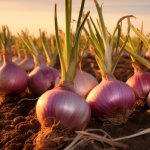Cultivated soybean, species Glycine max [(L.) Merrill], is a herbaceous plant, with an ideal height between 60 and 110 cm, belonging to the Leguminosae family. The soybean root system, according to Venetti and Gastal (1979), is composed of a main root and a large number of secondary roots distributed in rows along the main root. According to Nepomuceno et al. (2021), the main commercial varieties have a hispid and poorly branched stem, with trifoliate leaves. These authors also mention that soybeans have autogamous fertilization flowers, white, purple or intermediate in color, and develop pods that can contain one to five smooth, elliptical or globose seeds. These plants present indeterminate (without terminal raceme), determinate (with terminal raceme) or semi-determinate (intermediate) growth.
Soybeans are rich in protein, potassium, calcium, magnesium, phosphorus, copper and zinc, and are also a source of some vitamins such as B complex and ascorbic acid (vitamin C). For this reason, soybeans are widely used in animal and human nutrition. According to APROSOJA, in addition to being a functional food, soybeans are used to manufacture products such as chocolate, ready-made seasonings and pasta. Meat products also often contain soy in their composition, as do drink mixes, baby food and many diet foods. The oil extracted from the grain (approximately 15 % of soybean grain production is used to manufacture oil) is used to produce cooking oil, salad dressing, margarine, vegetable fat and mayonnaise. The process of obtaining refined soybean oil produces lecithin, an emulsifying agent widely used to manufacture sausages, mayonnaise, ice cream, chocolate drinks, cereal bars and frozen products. Another segment of food products that uses soy is ready-to-drink beverages – soy-based milk and fruit juices.
Furthermore, APROSOJA notes that, in recent commercial history, due to its safety and abundance in terms of supply, soybean oil has become the main raw material for the production of biodiesel, a renewable fuel that helps reduce the emission of polluting gases into the environment. Biodiesel is composed of petroleum diesel and oil extracted from various oilseeds. Soybean oil represents more than 80 % of the total demand for biodiesel production in Brazil.
Origin and economic importance
The first reference to soybeans as a food dates back more than 5,000 years, in China, according to the Brazilian Association of Soybean Producers (APROSOJA). Furthermore, APROSOJA mentions that one of the main indicators that attest to the cultural and nutritional importance of soybeans for the Chinese is the fact that as early as 200 BC, the grain was the essential raw material for the production of tofu (curdled soy milk), having represented vegetable protein, milk, cheese, bread and oil for thousands of years for the Chinese. However, it was only after the end of the First World War, in 1919, that soybeans became an important foreign trade item. The year 1921 can be considered the year when the Chinese Association was founded. American Soybean Association (ASA), as a milestone in the consolidation of the soybean production chain on a global scale (APROSOJA).
In Brazil, according to APROSOJA, although there are historical records that point to experimental soybean cultivation in Bahia as early as 1882, the introduction of soybeans dates back to 1901: this is when cultivation began at the Campinas Agricultural Station and the distribution of seeds to producers in São Paulo. The grain began to be more easily available in the country after the intensification of Japanese migration in the 1900s. In 1914, it was officially introduced in Rio Grande do Sul – a state that has similar climate conditions to the producing regions in the United States (origin of the first cultivars, until 1975). The expansion of soybeans in Brazil began in the 1970s, when the oil industry began to expand. The increase in international demand for the grain was another factor that contributed to the beginning of large-scale commercial soybean cultivation.
Soybean farming is the country's main agricultural crop for export, giving Brazil a prominent position in the global agricultural scenario as the world's largest producer of this commodity in the 2022 harvest year - so far, followed by the United States and China. According to the 10th Harvest Survey, published by CONAB in July 2022, 40,950.6 thousand hectares were sown in this harvest, 4.5 % higher than the 2020/21 harvest. The production obtained was 124,05 thousand tons, 10.2 % lower than the 2020/21 harvest, and the average productivity achieved was 3,029 kg ha-1. Still according to this Survey, the influence of the phenomenon La Niña in the Southern Region and in Mato Grosso do Sul, with a drastic reduction in rainfall, was decisive in reducing productivity in these regions and, consequently, in total soybean production in the country. The State of Mato Grosso has consolidated itself as the largest national producer, followed by the States of Goiás, Minas Gerais, São Paulo, Paraná and MATOPIBA – an important region for the expansion of the country's agricultural frontier, which includes the states of Maranhão, Tocantins, Piauí and Bahia, according to data released by IBGE (2022).
Furthermore, soybean is one of the crops that best adapts to the no-tillage system, being the main crop to compose crop-pasture rotation systems, not only due to economic aspects, but also because it is an efficient fixer of atmospheric nitrogen (Kluthcouski & Stone 2003). Furthermore, Debiasi and Franchini (2012) mention that the crop-livestock integration system can contribute to the sustainability of soybean production in different Brazilian regions, constituting an option to increase and diversify the producer's income and improve the quality of the no-tillage system.
Soybean management
Of the climatic elements, temperature, photoperiod and water availability are those that most affect soybean development and productivity (Farias et al., 2007). According to these authors, abiotic stresses such as drought, excessive rainfall, very high or low temperatures, low light, etc., can significantly reduce crop yields and restrict the locations, times and soils where commercially important species can be cultivated. These authors also mention that soybeans adapt better to regions where temperatures range between 20 ºC and 30 ºC, with the ideal temperature for their development being around 30 ºC.
Regarding water availability, soybeans are very sensitive to water deficits during the establishment, flowering and grain filling phases. The vegetative growth phase is less affected by water shortages (Franchini et al., 2016). These authors also mention that soil characteristics also have a decisive influence on the performance of this oilseed, since they determine the availability of water, nutrients and oxygen to plants, as well as the resistance that the soil imposes on root growth. Soybean plants prefer deep, medium-textured soils (with at least 15 % of clay), well-drained and with flat or slightly undulating topography. The ideal pH range is close to 6.0, where there is greater availability of macronutrients and micronutrients.
Regarding nutritional requirements, the element most required by soybeans is nitrogen, which is obtained, to a small extent, from the soil (25 % to 35 %) and, to a greater extent, through symbiotic nitrogen fixation (65 % to 85 %). Therefore, inoculation is a very important process in soybean production, and must be done with a good quality inoculant, to have maximum efficiency in the symbiotic fixation of nitrogen from the air, which is carried out by bacteria in the nodules of the plant's roots. For symbiotic fixation to be efficient, it is necessary to correct the soil acidity and provide the nutrients that are in limiting quantities. Next, the most required elements are potassium, sulfur and phosphorus. Regarding micronutrients, it is important to note the small quantities necessary to supply the soybean crop. Micronutrients, although required in smaller quantities, are no less important. According to Borkert et al. (1994), soybeans have been proven to require the micronutrients boron, copper, manganese, zinc, molybdenum and cobalt.
The next BLOG will present and discuss the nutritional management program suggested by ILSA for soybean crops.
Bibliographic references
Brazilian Crop Monitoring – Grains. 10th Survey, National Supply Company (CONAB), July 2022. Available at: https://www.conab.gov.br/
Brazilian Soybean Producers Association (APROSOJA Brazil) – Available at: https://aprosojabrasil.com.br/a-soja/
BORKERT, CM; YORINORI, JT; CORRÊA-FERREIRA, BS; ALMEIDA, AMR; FERREIRA, LP; SFREDO, GJ Be the doctor of your soybean. Potafós, Agronomic Information, n. 66, 1994. 17 p.
DEBIASI, H.; FRANCHINI, JC Soil physical attributes and soybean productivity in an integrated crop-livestock system with brachiaria and soybean. Ciência Rural, Santa Maria, v.42, n.7, p. 1180-1186, 2012.
FARIAS, JRB; NEPOMUCENO, AL; NEUMAIER, N. Soybean ecophysiology. Technical Circular, Embrapa Soja, Londrina, n. 48, 2007. 9 p.
FRANCHINI, JC; BALBINOT JR., AA; DEBIASI, H.; COSTA, JM; SICHIERI, FR; TEIXEIRA, LC Soybean in sandy soils: role of the No-Tillage System and Crop-Livestock Integration. Technical Circular, Embrapa Soja, Londrina, n. 116, 2016. 10 p.
IBGE Indicators: Systematic Survey of Agricultural Production – Agricultural Production Statistics, 2022. Available at: https://biblioteca.ibge.gov.br/visualizacao/periodicos/2415/epag_2022_maio.pdf
KLUTHCOUSKI, J.; STONE, LF Sustainable management of Cerrado soils. In: KLUTHCOUSKI, J.; STONE, LF; AIDAR, H. Crop-livestock integration. Santo Antônio de Goiás: Embrapa, 2003. p. 61-104.
NEPOMUCENO, AL; FARIAS, JRB; NEUMAIER, N. Soybean characteristics. Embrapa Soja, online article. 2021.
VERNETTI, FJ; GASTAL, MFC Botanical description of soybean. Technical Circular, Embrapa, Pelotas, n. 7, 1979. 11 p.
Authors
- Agricultural Eng. Msc. Aline Tramontini dos Santos
- Agricultural Eng. Msc. Carolina Custodio Pinto
- Agricultural Eng. Msc. Thiago Stella de Freitas






